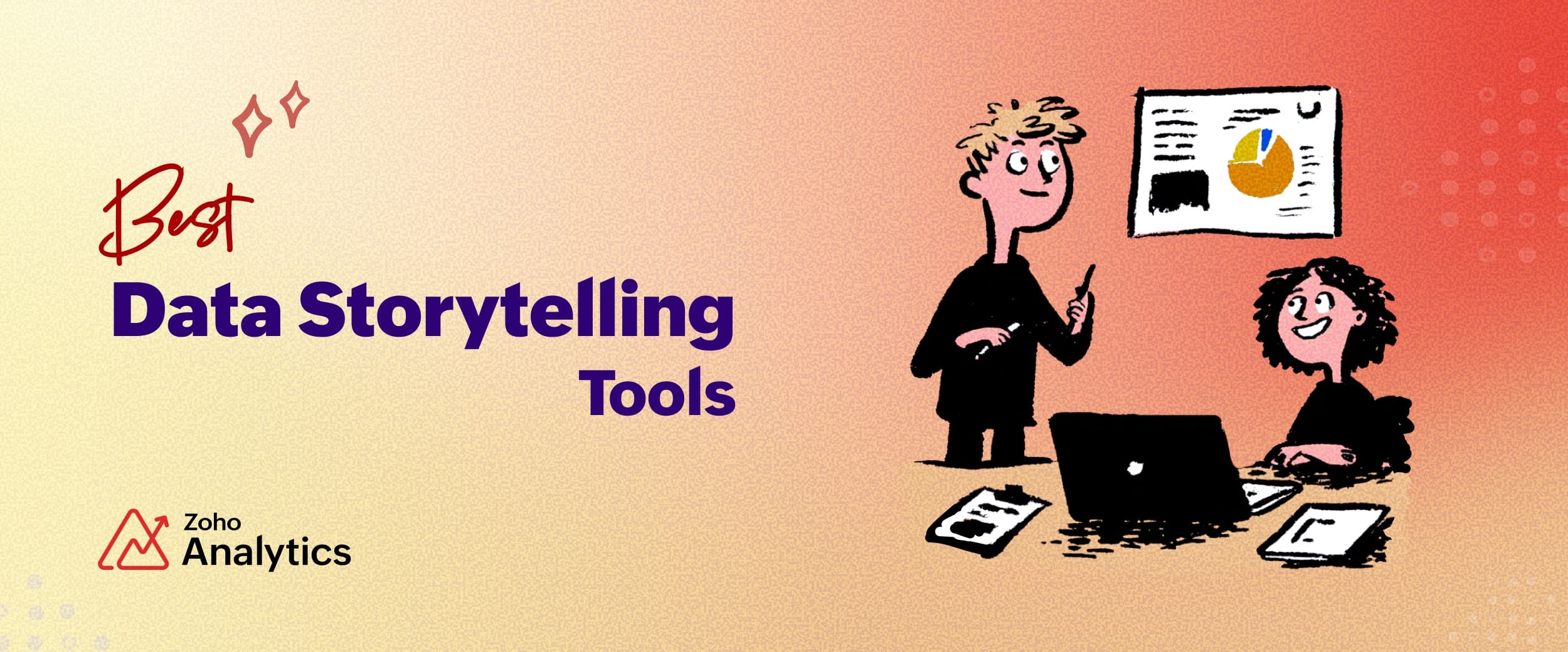- HOME
- BI & Analytics
- How to Choose the Right Chart Type for Data Visualization?
How to Choose the Right Chart Type for Data Visualization?
- Last Updated : December 8, 2025
- 3.2K Views
- 10 Min Read
Do you often wonder whether to use a pie chart or a bar graph to show proportions? If you're struggling to find the right way to present your data, you're not alone. With so many data visualization types to choose from, it’s easy to feel overwhelmed and end up with visuals that confuse rather than clarify.
Using the wrong chart or graph can distort your message, which may lead to misinterpreted or missed insights. This not only wastes time but also damages your credibility with stakeholders.
In this guide, we’ll show you how to choose the right visualization type for your specific data and goals. Whether you’re presenting trends, comparisons, or relationships, we’ll help you make informed decisions that turn complex data into clear, actionable insights.

Key considerations when choosing data visualizations
Choosing the right data visualization isn’t just about selecting a chart that looks appealing; it’s about selecting a visual that best communicates the story your data tells. Below are the key considerations to keep in mind when making your decision.
Data type
Understanding your data is the first step. The structure of your data—whether it’s categorical, numerical, hierarchical, or geographical—dictates the most appropriate visualization type.
By understanding the nature of your data, you can narrow down the types of charts that will effectively convey your insights.
Purpose of the visualization
Your visualization should directly serve the purpose of your analysis. Ask yourself, “What am I trying to show?” Are you comparing values, demonstrating changes over time, showing parts of a whole, or visualizing relationships? Each purpose uses different types of charts.
Choosing a chart that aligns with your goal ensures your data story is clear and engaging.
Understanding your audience
Tailoring the complexity of your visualizations to your audience is critical. If your viewers are non-technical, simple charts like bar graphs or pie charts may be more appropriate. For a more specialized or technical audience, complex visualizations like scatter plots, Sankey diagrams, or heat maps may be suitable.
Additionally, for those beginning their data visualization journey or working within budget constraints, exploring free data visualization tools can be beneficial. These tools often provide a range of basic to advanced features, enabling users to create effective visualizations without financial investment.
Context
Finally, think about where your visualizations will be used. Visuals for a large report or dashboard can include more complex details than visuals for a presentation slide.
By considering these factors, you can confidently select the most effective visualization for your data.
How to choose the right data visualization?
When choosing a data visualization, it’s essential to understand what each chart is best suited for. Below, we categorize common data visualization charts based on their functions and explain when to use them for your data analysis.
Types of data visualizations charts and when to use them
1. Charts for showing change over time & comparisons
Visualizing change over time helps identify patterns, trends, and shifts in performance. Line charts are ideal for tracking metrics like revenue or traffic over months or years. Use area charts to emphasize volume, or column charts to compare categories across time. These charts are essential for highlighting growth, decline, or seasonality in your data.
Bar chart
Bar charts use horizontal or vertical bars to represent data. They're best for comparing values across distinct categories, such as sales by region or product performance.

Stacked bar chart
Stacked bar charts break down and compare parts of a whole across categories. You can use bar charts when you want to show how different sub-categories contribute to the total value over multiple categories (e.g., sales by region, broken down by product type).

Combo chart
Combo charts combine two chart types, typically bars and lines, to show different kinds of information together. These are ideal for comparing two different types of data in one view, such as revenue (bar) and profit margin (line) over time.

Line chart
Line charts display trends over time by connecting data points with a line. This chart type can be used for time-series data—like stock prices, website traffic, or monthly sales figures—to illustrate trends or fluctuations over a period of time.

Area chart
Area charts are similar to a line chart, but the space between the line and the X-axis is filled in. They're best for visualizing cumulative data over time, such as showing revenue growth or total users across months.

Race chart
Race charts show animated changes in values over time for different categories, where bars change position as values fluctuate. Use this type of chart if you want to show rank changes over time dynamically, like population growth or monthly sales.

When to use comparison and distribution charts: Use these charts when you need to compare values across categories, show trends over time, or visualize distribution patterns. These charts are versatile for both small and large datasets and help in understanding how categories or time periods perform relative to others. |
Ready to bring your data to life? Use Zoho Analytics to create stunning data visualization charts with just a few clicks. |
2. Charts for showing part-to-whole and hierarchies
Use these charts to understand how individual components contribute to a whole or how data is structured across levels. Pie charts work well for simple proportions, while treemaps or sunbursts reveal deeper hierarchies. Funnel charts are great for showing stage-wise drop-offs in processes like sales or onboarding.
Pie chart
Pie charts divide a circle into slices to represent portions of a whole. They're ideal for showing simple proportions or percentages, such as market share distribution. Pie charts are best used for five or fewer categories.

Tree map
Tree maps display hierarchical data as nested rectangles where the size of each rectangle corresponds to its value. You can use tree maps when you want to show hierarchical data (e.g., sales by department, sub-department, and product) in a compact visual form.

Sunburst chart
Sunburst charts are a radial visualization where each ring represents a level in the hierarchy. They're best for visualizing multilevel hierarchical data, like organizational structures or folder and file breakdowns.

Sankey diagram
Sankey diagrams visualize flow data, with the width of the flow indicating the quantity. You can use these diagrams to illustrate flow between categories, like web traffic between pages or budget allocations across departments.

Funnel chart
Funnel charts show the progressive reduction of data as it passes through different stages and are often used in processes like sales or lead generation. Use this type of chart when visualizing stages in a process, such as the customer journey from awareness to purchase.

When to use part-to-whole and hierarchical charts: Use these charts when your goal is to show how individual parts contribute to a whole or to explore hierarchical relationships within your data. These charts are great for representing proportional data or visualizing systems with multiple levels. |
3. Charts for showing relationships between variables
To explore correlations or patterns across multiple variables, use charts like the scatter plot. It helps identify trends, outliers, or clusters between two data points. Bubble charts add an extra dimension with size, making them useful for comparing across three metrics simultaneously.
Scatter plot
Scatter plots show the relationships between numerical variables using points on a grid. They're useful when analyzing the correlation or relationship between two variables, such as age vs. income or marketing spending vs. sales.

Bubble chart
Bubble charts extend the scatter plot by adding a third dimension (i.e., the size of the bubble) that represents another variable. Use bubble charts when you need to compare three variables at once, like revenue (X-axis), profit (Y-axis), and market share (bubble size).

Web chart
Web charts are radial graphs where multiple variables are plotted along separate axes from the center. They're best for showing performance across multiple metrics, such as competitor analyses or employee skill assessments.

When to use relationship and correlation charts: These charts are perfect for exploring relationships or correlations between different variables. They help in identifying patterns, trends, or anomalies between data sets and are valuable in statistical analysis and hypothesis testing. |
Ready to bring your data to life? Use Zoho Analytics to create stunning data visualization charts with just a few clicks. |
4. Charts for showing geography & spatial patterns
When location matters, spatial charts help uncover regional trends and distribution. Use a map chart to compare values across geographies, or a geo heat map to highlight intensity. Perfect for analyzing sales by region, user distribution, or support coverage.
Map chart
Map charts visualize data across geographical areas using color coding, bubbles, or patterns to represent values. This type of chart is ideal for showing data sets that have geographical components, such as population density, sales by region, or election results.

Heat map
Heat maps use color intensity to represent data density or magnitude, often over a geographical area or a matrix. Use heat maps when visualizing patterns, such as website clicks by region or customer distribution.

When to use geographical and spatial data charts: Use these charts when your data has a geographical component or requires spatial representation. These charts are ideal for showing distribution or performance across regions. |
By understanding the strengths of each chart type and when to use them, you’ll be able to convey your data in the clearest, most impactful way possible.
What not to do when choosing data visualization
Here are some common pitfalls to avoid when designing data visualizations:
Overcomplicating the chart
One of the most frequent errors in data visualization is trying to display too much information in one chart. Overloading your chart with excessive data points, multiple chart types, or too many colors can overwhelm your audience and make it difficult to interpret the data.
Solution: Keep your charts simple and focused on a single message. If necessary, break your data into multiple visuals to maintain clarity. Less is often more when it comes to conveying insights effectively.
Using too many colors
Color is a powerful tool in data visualization, but overusing it can cause confusion. Too many colors or not enough contrast can make it difficult for viewers to focus on what matters most. Color also conveys meaning, so using inconsistent color schemes can make it harder to interpret the data.
Solution: Use color strategically. Stick to a minimal, consistent color palette that draws attention to the most important elements of your data. Avoid using more than five colors in a single chart, and make sure to use contrasting colors for clarity.
Lack of labels and annotations
Charts without proper labeling can leave viewers guessing about what the data represents. Failing to label your axes, not providing units of measurement, or not including annotations can make your visualization unclear or incomplete.
Solution: Always include clear, concise labels on your axes and data points. Provide titles and brief descriptions that explain what the data is showing.
Choosing the wrong chart type
Selecting the wrong chart can lead to misinterpretation or confusion. Although our guide can be helpful in choosing the right data visualization type, it's not ideal to refer to it every time you create a visualization.
Solution: Let Zoho Analytics handle your data visualization needs. Powered by AI, Zoho Analytics is a BI and analytics platform that automatically selects the best visualization for your data.
Related read: 5 best data visualization tools for understanding your data better
Best practices to follow in data visualization charts
Creating effective data visualizations involves more than just choosing the right chart type; it requires thoughtful design and attention to detail. Here are some best practices to ensure your visuals communicate data clearly and effectively:
Keep it simple
The goal of any data visualization is to make data easy to understand. Avoid unnecessary complexity by focusing on the key message you want to convey. Simplify your chart design by removing distractions like grid lines or excessive data points. A clean, minimal design keeps the viewer’s attention on the data.
💡Tip: Ask yourself, “Can I remove this element without losing meaning?” If yes, it’s probably not necessary.
Use consistent colors
Consistency in color schemes is essential for clarity. When working with multiple charts in a dashboard or report, maintain a consistent color palette to help users quickly associate colors with categories.
💡Tip: Stick to a limited color palette with a maximum of five or six colors. Use contrasting colors only to highlight important data points.
Label clearly and add annotations
Proper labeling ensures that your audience understands what they’re looking at. Always include descriptive titles, clear axis labels, and units of measurement.
💡Tip: Avoid cluttering the chart with too much text. Keep labels concise but informative.
How Zoho Analytics simplifies data visualization
Zoho Analytics offers two simple ways to create data visualizations:
Drag-and-drop visualization builder: Just drag and drop the required columns into the respective fields and click the Generate button. Zoho Analytics automatically creates a visualization based on your data type, which you can change as needed.
Check out our guide on creating data visualizations using Zoho Analytics (with videos)
AI agent: You can easily use Ask Zia, Zoho's AI agent, by asking questions in plain language. Zia will generate reports and dashboards for you in only a few seconds.
Other key features:
Support for 500+ data sources, such as cloud business apps, files and feeds, databases, data lakes, and data warehouses
Built-in AI-powered data preparation studio
Dynamic and interactive data visualizations
Advanced sharing and collaboration options
Data alerts
Options to embed visualizations
Automated interactive slideshow generation
Ready to try Zoho Analytics?
Sign up with Zoho Analytics for a 15-day free trial and explore how easy it is to create data visualizations.

Key takeaways
The key to successful data visualization lies in understanding your data, the purpose of your visualization, and your audience’s needs. By selecting the appropriate chart type, you ensure that your message is clear, impactful, and easy to understand.
Bookmark this blog for quick guidance on selecting the right visualization type whenever you need it. Alternatively, choose Zoho Analytics as your data visualization software and create insightful visualizations with ease.
Data visualization chart FAQs
1. What should I consider when deciding on the right data visualization?
Choose a chart based on your data story, whether showing trends, comparisons, relationships, composition, or geography. Keep clarity, audience understanding, and purpose in mind to make insights intuitive and impactful.
2. What are the types of visualization charts supported in Zoho Analytics?
Zoho Analytics supports charts for trends, composition, relationships, and geography, like line, bar, area, pie, treemap, funnel, scatter, radar, map, and more, including interactive and advanced visualization options.
3. How do you determine which visualization to pick?
Start with your goal: show trends (line), compare values (bar), show parts of a whole (pie), relationships (scatter), or locations (map). Pick what communicates insights quickly and clearly.
4. How to determine the right desktop app for advanced data visualization needs?
Choose a tool based on data complexity, integration needs, interactivity, and ease of use. Zoho Analytics offers powerful, intuitive options for both simple and advanced visualization tasks.
 Pradeep V
Pradeep VPradeep is a product marketer at Zoho Analytics with a deep passion for data and analytics. With over eight years of experience, he has authored insightful content across diverse domains, including BI, data analytics, and more. His hands-on expertise in building dashboards for marketing, sales, and major sporting events like IPL and FIFA adds a data-driven perspective to his writing. He has also contributed guest blogs on LinkedIn, sharing his knowledge with a broader audience. Outside of work, he enjoys reading and exploring new ideas in the marketing world.


